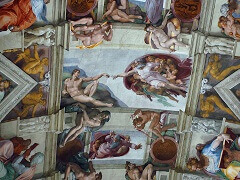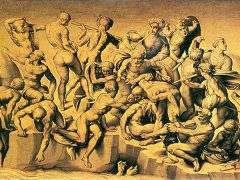Taddei Tondo, by Michelangelo

The Taddei Tondo, now at the Royal Academy in London, was carved for Taddeo Taddei, as recalled by both Vasari (1550, 1568) and Benedetto Varchi (1564). Similar to the Pitti Tondo as concerns subject and perhaps chronology, the work depicts a very different moment of reflection on the subject of the Madonna and Child with the Infant Saint John: as much as the Florentine composition expresses the subject in terms of dignified and prescient knowledge, the London work animates it with reciprocal tensions between the sacred players. The Infant Saint John to the left, who already wears the animal skin and bowl of his future hermitage as Precursor in the desert, crosses his wrists as he holds his arms out to Jesus while offering him a little bird (the robin or goldfinch symbolizing the Passion) and another object, left unfinished and only implied in the residual marble.
Although a crown of thorns has been suggested, it was more likely meant to be a scroll with the words "Ecce Agnus Dei". Faced with the multiple prophetic signs of his own destiny, the infant Christ bounds forwards in fear and hides in his mother's lap, whereupon Mary, whose pose is that of "humility", gathers him up, placing her right hand on the infant Saint John's shoulder to stop him from advancing any further. The scene appears to feature the credible liveliness of a domestic episode, where the naughty child frightens his little cousin and is gently but firmly reproached by his aunt, if it weren't for the deep-seated and subtle theological implications that accompany it, and that critics at the time had no difficulty interpreting. A fitting recollection here is of the letter written by Isabella d'Este's agent who, while commenting on the mutual fleeting attitudes of Anne, Mary, Jesus and the Infant Saint John in The Cartoon of St. Annen by Leonardo da Vinci, interprets them in light of the Church's disapproval of the Madonnas efforts to save her Son from the Passion. To go back to Michelangelo, the sacred intangibility of the body of Christ, who has no contact whatsoever with his Mother's flesh, is respected here once again.
















